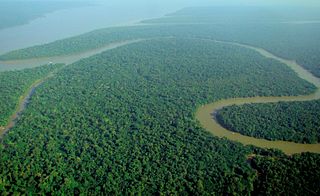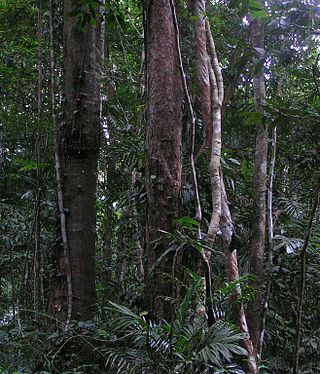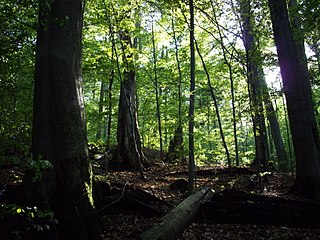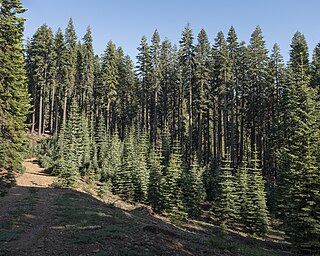
Ecological succession is the process of change in the species that make up an ecological community over time.

Tropical rainforests are dense and warm rainforests with high rainfall typically found between 10 degrees north and south of the equator. They are a subset of the tropical forest biome that occurs roughly within the 28-degree latitudes. Tropical rainforests are a type of tropical moist broadleaf forest, that includes the more extensive seasonal tropical forests. True rainforests usually occur in tropical rainforest climates where there is no dry season – all months have an average precipitation of at least 60 mm. Seasonal tropical forests with tropical monsoon or savanna climates are sometimes included in the broader definition.
Silviculture is the practice of controlling the growth, composition/structure, as well as quality of forests to meet values and needs, specifically timber production.

An old-growth forest is a forest that has developed over a long period of time without disturbance. Due to this, old-growth forests exhibit unique ecological features. The Food and Agriculture Organization of the United Nations defines primary forests as naturally regenerated forests of native tree species where there are no clearly visible indications of human activity and the ecological processes are not significantly disturbed. One-third of the world's forests are primary forests. Old-growth features include diverse tree-related structures that provide diverse wildlife habitats that increases the biodiversity of the forested ecosystem. Virgin or first-growth forests are old-growth forests that have never been logged. The concept of diverse tree structure includes multi-layered canopies and canopy gaps, greatly varying tree heights and diameters, and diverse tree species and classes and sizes of woody debris.

Clearcutting, clearfelling or clearcut logging is a forestry/logging practice in which most or all trees in an area are uniformly cut down. Along with shelterwood and seed tree harvests, it is used by foresters to create certain types of forest ecosystems and to promote select species that require an abundance of sunlight or grow in large, even-age stands. Logging companies and forest-worker unions in some countries support the practice for scientific, safety and economic reasons, while detractors consider it a form of deforestation that destroys natural habitats and contributes to climate change. Environmentalists, traditional owners, local residents and others have regularly campaigned against clearcutting, including through the use of blockades and nonviolent direct action.

A secondary forest is a forest or woodland area which has regenerated through largely natural processes after human-caused disturbances, such as timber harvest or agriculture clearing, or equivalently disruptive natural phenomena. It is distinguished from an old-growth forest, which has not recently undergone such disruption, and complex early seral forest, as well as third-growth forests that result from harvest in second growth forests. Secondary forest regrowing after timber harvest differs from forest regrowing after natural disturbances such as fire, insect infestation, or windthrow because the dead trees remain to provide nutrients, structure, and water retention after natural disturbances. Secondary forests are notably different from primary forests in their composition and biodiversity; however, they may still be helpful in providing habitat for native species, preserving watersheds, and restoring connectivity between ecosystems.

In forestry, windthrow refers to trees uprooted by wind. Breakage of the tree bole (trunk) instead of uprooting is called windsnap. Blowdown refers to both windthrow and windsnap.

Forest ecology is the scientific study of the interrelated patterns, processes, flora, fauna and ecosystems in forests. The management of forests is known as forestry, silviculture, and forest management. A forest ecosystem is a natural woodland unit consisting of all plants, animals, and micro-organisms in that area functioning together with all of the non-living physical (abiotic) factors of the environment.

In ecology, a disturbance is a temporary change in environmental conditions that causes a pronounced change in an ecosystem. Disturbances often act quickly and with great effect, to alter the physical structure or arrangement of biotic and abiotic elements. A disturbance can also occur over a long period of time and can impact the biodiversity within an ecosystem.

A treefall gap is a distinguishable hole in the canopy of a forest with vertical sides extending through all levels down to an average height of 2 m (6.6 ft) above ground. These holes occur as result of a fallen tree or large limb. The ecologist who developed this definition used two meters because he believed that "a regrowth height of 2 m was sufficient" for a gap to be considered closed, but not all scientists agree. For example, Runkle believed that regrowth should be 10–20 m (33–66 ft) above the ground. Alternatively, a treefall gap is "the smallest gap [that must] be readily distinguishable amid the complexity of forest structure."
Management of Pacific Northwest riparian forests is necessary because many of these forests have been dramatically changed from their original makeup. The primary interest in riparian forest and aquatic ecosystems under the Northwest Forest Plan (NWFP) is the need to restore stream habitat for fish populations, particularly anadromous salmonids. Some of these forests have been grazed by cattle or other livestock. The heavy hooves of these animals compact the soil. This compaction does not allow the water to be absorbed into the ground, so the water runs off into the stream carrying topsoil along the way.

Temperate deciduous or temperate broad-leaf forests are a variety of temperate forest 'dominated' by deciduous trees that lose their leaves each winter. They represent one of Earth's major biomes, making up 9.69% of global land area. These forests are found in areas with distinct seasonal variation that cycle through warm, moist summers, cold winters, and moderate fall and spring seasons. They are most commonly found in the Northern Hemisphere, with particularly large regions in eastern North America, East Asia, and a large portion of Europe, though smaller regions of temperate deciduous forests are also located in South America. Examples of trees typically growing in the Northern Hemisphere's deciduous forests include oak, maple, basswood, beech and elm, while in the Southern Hemisphere, trees of the genus Nothofagus dominate this type of forest. Temperate deciduous forests provide several unique ecosystem services, including habitats for diverse wildlife, and they face a set of natural and human-induced disturbances that regularly alter their structure.

Even-aged timber management is a group of forest management practices employed to achieve a nearly coeval cohort group of forest trees. The practice of even-aged management is often pursued to minimize costs to loggers. In some cases, the practices of even aged timber management are frequently implicated in biodiversity loss and other ecological damage. Even-aged timber management can also be beneficial to restoring natural native species succession.
FORECAST is a management-oriented, stand-level, forest-growth and ecosystem-dynamics model. The model was designed to accommodate a wide variety of silvicultural and harvesting systems and natural disturbance events in order to compare and contrast their effect on forest productivity, stand dynamics, and a series of biophysical indicators of non-timber values.
Monodominance is an ecological condition in which more than 60% of the tree canopy comprises a single species of tree. Monodominant forests are quite common under conditions of extra-tropical climate types. Although monodominance is studied across different regions, most research focuses on the many prominent species in tropical forests. Connel and Lowman, originally called it single-dominance. Conventional explanations of biodiversity in tropical forests in the decades prior to Connel and Lowman's work either ignored monodominance entirely or predicted that it would not exist.

Gap dynamics refers to the pattern of plant growth that occurs following the creation of a forest gap, a local area of natural disturbance that results in an opening in the canopy of a forest. Gap dynamics are a typical characteristic of both temperate and tropical forests and have a wide variety of causes and effects on forest life.

The Japanese temperate rainforest is well sustained and maintains a high biodiversity. One method that has been utilized in maintaining the health of forests in Japan has been afforestation. The Japanese government and private businesses have set up multiple projects to plant native tree species in open areas scattered throughout the country. This practice has resulted in shifts in forest structure and a healthy temperate rainforest that maintains a high biodiversity.
In ecology regeneration is the ability of an ecosystem – specifically, the environment and its living population – to renew and recover from damage. It is a kind of biological regeneration.

In ecology, a light gap is a break in forest canopy or similar barrier that allows young plants to grow where they would be otherwise inhibited by the lack of light reaching the seedbed. Light gaps form predominantly when a tree falls, and thus produces an opening in the forest canopy. Light gaps are important for maintaining diversity in species-rich ecosystems.
Oak regeneration failure is a woodland phenomenon whereby insufficient oak (Quercus) seedlings and saplings are recruited into the canopy to replace dead mature oaks. The result is a local decline in oak numbers while other more shade-tolerant trees such as maple, lime, and ash may become more prominent. Oak regeneration failure has been observed across Eastern and Midwestern forests in the United States as well as in Europe.














